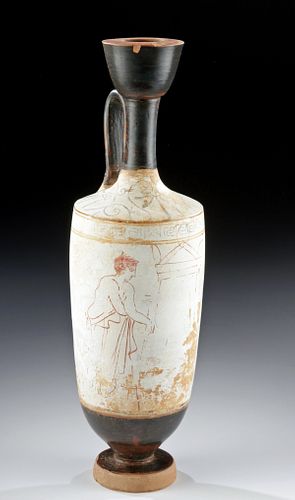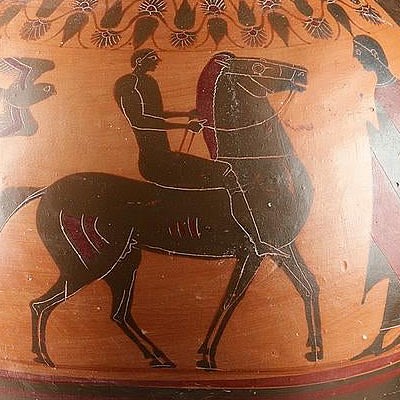Attic White-Ground Lekythos by Reed Painter ex MFA, TL
Lot 22d
About Seller
Artemis Fine Arts
686 S Taylor Ave, Ste 106
Louisville, CO 80027
United States
Selling antiquities, ancient and ethnographic art online since 1993, Artemis Gallery specializes in Classical Antiquities (Egyptian, Greek, Roman, Near Eastern), Asian, Pre-Columbian, African / Tribal / Oceanographic art. Our extensive inventory includes pottery, stone, metal, wood, glass and textil...Read more
Categories
Estimate:
$25,000 - $35,000
Absentee vs Live bid
Two ways to bid:
- Leave a max absentee bid and the platform will bid on your behalf up to your maximum bid during the live auction.
- Bid live during the auction and your bids will be submitted real-time to the auctioneer.
Bid Increments
| Price | Bid Increment |
|---|---|
| $0 | $25 |
| $300 | $50 |
| $1,000 | $100 |
| $2,000 | $250 |
| $5,000 | $500 |
| $10,000 | $1,000 |
| $20,000 | $2,500 |
| $50,000 | $5,000 |
| $100,000 | $10,000 |
| $200,000 | $20,000 |
About Auction
By Artemis Fine Arts
Jun 4, 2020
Set Reminder
2020-06-04 10:00:00
2020-06-04 10:00:00
America/New_York
Bidsquare
Bidsquare : Exceptional Antiquities, Asian, Ethnographic
https://www.bidsquare.com/auctions/artemis-gallery/exceptional-antiquities-asian-ethnographic-5185
An important one-day auction featuring museum-worthy examples of Egyptian, Greek, Roman, Etruscan, Near Eastern, Far East / Asian, Pre-Columbian, African / Tribal, Oceanic, Native American, Spanish Colonial, Russian, Fossils, Ancient Jewelry, Fine Art, so much more! Artemis Fine Arts info@artemisfinearts.com
An important one-day auction featuring museum-worthy examples of Egyptian, Greek, Roman, Etruscan, Near Eastern, Far East / Asian, Pre-Columbian, African / Tribal, Oceanic, Native American, Spanish Colonial, Russian, Fossils, Ancient Jewelry, Fine Art, so much more! Artemis Fine Arts info@artemisfinearts.com
- Lot Description
Ancient Greece, The Reed Painter, ca. 440 to 425 BCE. A stunning white ground lekythos attributed to the Reed Painter, adorned with a hand drawn/painted central scene in matt red-brown depicting a stele upon a stepped base, topped with a pediment with curved akroteria at both ends. To the left is a youth donning a himation draped across his body. Opposite, on the right, is a young lady, her coiffure in a top-knot, wearing a sleeveless chiton and himation. Framing the top of the scene is a register of meander punctuated by saltire-crossed squares. The shoulder is adorned with three palmettes and tendrils, hand painted in black. Size: 12.125" H (30.8 cm)
This piece has been attributed to the infamous Reed Painter who specialized in white ground lekythoi that depicted actual people rather than mythical beings as was more typical of black figure painters. It has wonderful provenance and once belonged to the Boston Museum of Fine Arts. Similar examples are featured in other fine museum collections such as that of the Art of Institute Chicago, the John Paul Getty Museum, and the Metropolitan Museum of Fine Arts. The Reed Painter executed his paintings in the true white-ground technique, outlining/sketching figures on the white ground, initially with a diluted reddish brown glaze and then following up with a more matt red or black. The coloration was added after the piece was fired. The subjects depicted were typically modeled upon real people rather than mythical figures - this in accordance with the white-ground lekythoi tradition. Most often, the Reed Painter depicted visitors to a tomb. The Reed Painter's name stems from his depiction of reeds in his work, especially those vessels of Charon.
Lekythos vases were among the various offerings and monuments paying tribute to the deceased in Athenian cemeteries. Lekythoi traditionally held oil and were decorated in the white ground technique from the middle until the end of the fifth century BCE. The term white ground relates to the light slip coating on the body and shoulder of the vase. Upon this background, figures and accoutrements were drawn in outline and then hand painted in rich colors. The iconography traditionally features tombs, visitors to these tomb sights, and touching farewell scenes, as the vast majority of these vessels were created for burial with the dead or to be offerings presented at their graves.
See other examples of white-ground lekythoi attributed to the Reed Painter at the Metropolitan Museum of Art (Accession Number 53.107)
Cf: John H. Oakley. Picturing Death in Classical Athens: The Evidence of the White Lekythoi. Cambridge: Cambridge University Press, 2004.
This piece has been tested using thermoluminescence (TL) analysis and has been found to be ancient and of the period stated. A full report will accompany purchase.
Provenance: private East Coast, USA collection; ex-private Hunter/Gilmore collection, acquired 2011; ex-Charles Ede collection, ex-Mrs. May Sheppard Jordan (1921); deaccessioned from the Boston Museum of Fine Arts (accession no. 21.275)
All items legal to buy/sell under U.S. Statute covering cultural patrimony Code 2600, CHAPTER 14, and are guaranteed to be as described or your money back.
A Certificate of Authenticity will accompany all winning bids.
We ship worldwide and handle all shipping in-house for your convenience.
#149778Normal surface wear with some pigment loss commensurate with age. Areas of white ground have lifted and there is some retouching of old glaze on lower bowl, neck, and lip. Chips/abrasions to rim and foot. There is a plastic plug inserted in center of the foot.Condition
- Shipping Info
-
All shipping is handled in-house for your convenience. Your invoice from Artemis Gallery will include shipping calculation instructions. If in doubt, please inquire BEFORE bidding for estimated shipping costs for individual items.
-
- Buyer's Premium



 EUR
EUR CAD
CAD AUD
AUD GBP
GBP MXN
MXN HKD
HKD CNY
CNY MYR
MYR SEK
SEK SGD
SGD CHF
CHF THB
THB













